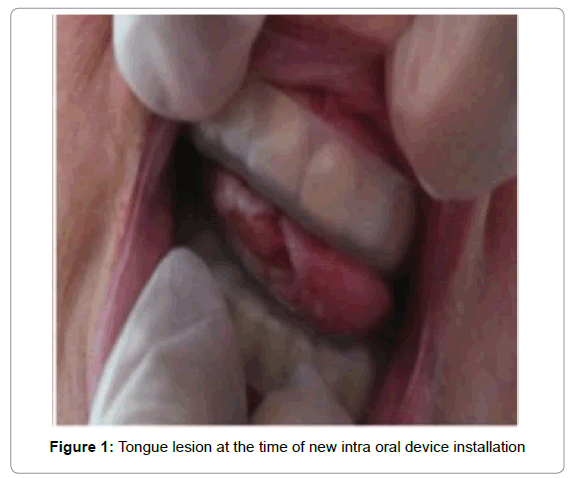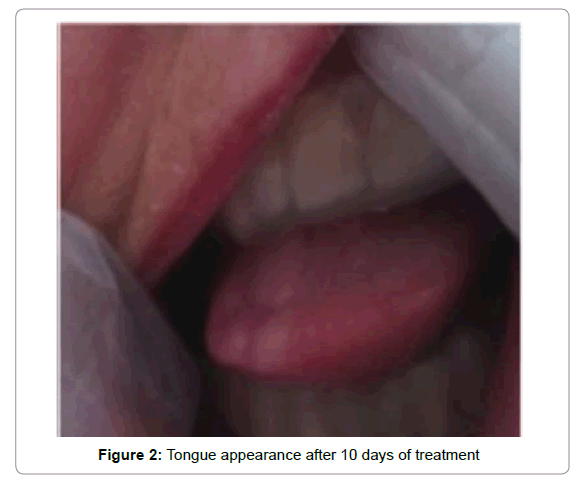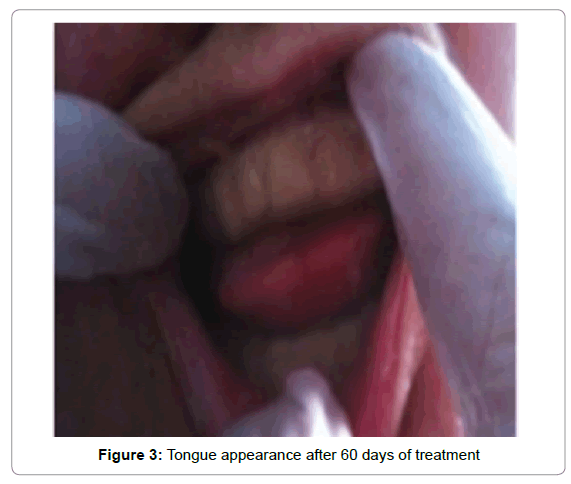Case Report Open Access
Dental Management of Oral Self-Injury in a Stroke Patient: Case Report and Literature Review
Monira Samaan Kallás*, Paulo Sergio da Silva Santos, Sumatra Melo da Costa Pereira Jales and Henrique Afonseca ParsonsPremier Residence Hospital, Sao Paulo, Brazil
- *Corresponding Author:
- Monira Samaan Kallás
Premier Residence Hospital
Sao Paulo, Av Paulista
960 ap 702 Bela Vista São Paulo/SP, Brazil 01310-100
Tel: +551-199-881-7525
E-mail: monira@usp.br
Received date: August 31, 2013; Accepted date: October 11, 2013; Published date: October 15, 2013
Citation: Kallás MS, da Silva Santos PS, da Costa Pereira Jales SM, Parsons HA (2013) Dental Management of Oral Self-Injury in a Stroke Patient: Case Report and Literature Review. J Palliat Care Med 3:163. doi:10.4172/2165-7386.1000163
Copyright: © 2013 Kallás MS et al., This is an open-access article distributed under the terms of the Creative Commons Attribution License, which permits unrestricted use, distribution, and reproduction in any medium, provided the original author and source are credited.
Visit for more related articles at Journal of Palliative Care & Medicine
Abstract
This study describes a case report of a female stroke patient with an oral self-injury. She was admitted to a palliative care hospital and after two weeks of hospitalization she presented with a severe tongue injury caused by frequent biting. We proposed a course of curative treatment and preventive measures to prevent re-injury. We also present a short literature review of these types of injuries. Even though this is only a case report on self-injury in stroke patients, our approaches were different from those described previously in the literature; we used a new combination of a silicon device and laser therapy to treat this lesion.
Keywords
Oral medicine; Palliative care; Oral-self injury; Dentistry in palliative care
Introduction
Cerebrovascular accidents most frequently occur in patients with existing cardiovascular disease, especially hypertension. An ischemic stroke results from sudden interruption of blood flow as a result of an arterial occlusion, while the rupture of a blood vessel causes hemorrhagic stroke [1]. Overall, the survival and the severity of the ensuing functional deficit depend on the type and the extent of the lesion [2].
Patients with long-term admissions in whom pain perception was lost due to the systemic disease need for oral care [3,4]. Patients normally injure themselves using their teeth, causing finger biting, tongue lacerations and ulcerations to the lips and other areas of the oral mucosa. Furthermore, it is normal to find dental luxation and severe attrition in such patients [5-7].
Self-inflicted oral injuries of organic origin are particularly common in certain diseases, syndromes, and systemic disorders. Patients whose stroke caused cognition loss can present with musclespasms and pain in their joints [8]. The temporo mandibular joint (TMJ) can be compromised and prone to self-injuries as an unconscious behavior [9,10]. These issues can delay wound cicatrization and may cause infection.
We present a case report of a patient who suffered a tongue selfinjury. The dental treatment was performed with minimum-risk interventions. An individualized combination of curative treatment with local procedures and the use of a prevention device were carried out.
Case Report
A female patient, had a hemorrhagic stroke at age 51. Five years later she had a second stroke with serious cognitive and motor consequences. She stayed in a general hospital for 2 years and was admitted in to a long-term facility six months before an oral event (described here).
On admission she arrives with oral silicone mouth guards for preventing self-bite injuries. The device was unfortunately lost during the admission process. After a week without it, the patient presented with an ulcerative lesion on the tip of the tongue (Figure 1). Oral evaluation showed normal teeth, gums, lips and buccal mucosa. Her coagulation rates were ok excluding blood related causes.
The ulcer treatment was handled by cleansing the area daily with saline solution and an application of triamcinolone acetonide. Preventive treatment was carried out 3 days after detection of the lesion with two new silicone mouths guards, one in the upper and other in the low jaw. Oral cleaning procedures such as teeth brushing with low foaming dental cream (Biotene®), tooth flossing, hydratation with artificial saliva (Biotene®) was continually done by a dental hygienist twice daily throughout the process.
Low-level laser therapy (LLLT) was used with an irradiance of 45 J per cm2 and duration of 33 seconds. It was applied in 3 sites around the lesion and the patient was treated at 2 days intervals, 3 times a week for 15 days. After these procedures, epithelial tissue was re-established as shown in Figure 2 and Figure 3.
Discussion
The sequelae of stroke can cause disability in loss of self perception and this can result in declining oral health which in turn can affect general health and quality of life in nursing home residents and Long Term Acute Care (LTAC) facilities [9,11-14]. The American Dental Association describes medications that affect oral hygiene, agents that alter plaque composition and pH, salivary flow and ph, and taste. There are also agents that cause angioedema, alter tissue pigmentation, cause gingival enlargement, and these can affect hemostasis and alveolar bone [15].
Disabled adults with severe movement disorders need special oral care to provide treatment as necessary [16,17]. Preventive oral health protocols are important in patients with physical impairment, sensory or cognitive deficits that cause lost of independent oral care [18-20].
It has been reported that oral self-injuries are most common in males in the early years of life, and the sites most frequently involved are the lower lip and the tongue. This group concluded that therapeutic approaches in these patients should include psychological and pharmacological treatments, intraoral devices, and surgical procedures when necessary [7].
The several case reports of oral self-injury published show that therapies consisting of self-guard devices, tooth extractions, medications and toxin botulinmn can be beneficial [7,10,21-27]. We note that even therapy must be individualized and professionals should direct their decisions based on pain relief, removal of infection focus and prevention of new lesions.
We decided to use a conservative approach that was based on a self-guard device. This avoided extraction of the patient’s tooth and minimized mutilation.
Oral hygiene is important for oral and general diseases prevention and this must be carefully observed in patients whose disease cause disabilities that prevent the performance of basic self care such as brushing teeth, gargling or spitting. A Cochrane review from 2008 shows that even further research is need in this area, and that staff training can improve oral hygiene in stroke patients. Professionally delivered oral care could improve the oral and general health of this population [28].
Due our partnership with a group of palliative care professionals for cancer patients, we used laser therapy as a curative procedure to complement daily oral hygiene. Although there is no protocol gold standard for laser (dose, power unit and application time), several studies show the benefit of this technique as an auxiliary tool for the treatment of oral mucosa lesions in patients undergoing therapy for cancer treatment [29-31].
Our case report on self-injury in stroke patients is different from previous reports since we used a new combination of therapies to treat this lesion. Further studies are needed.
Acknowledgements
Authors like to thank Dr. Samir Salman for his valuable efforts in Brazilian Palliative Care Medicine.
References
- Bodnar DC, Varlan CM, Varlan, V, Vaideanu T, Popa MB (2008) Dental Management in stroke patients. TMJ 58: 228-235.
- Gopal A (2008) Stroke and oral health. Vital 5: 40-42.
- Buhlin K, Gustafsson A, Pockley AG, Frostegård J, Klinge B (2003) Risk factors for cardiovascular disease in patients with periodontitis. Eur Heart J 24: 2099-2107.
- Limeres J, Feijoo JF, Baluja F, Seoane JM, Diniz M, et al. (2013) Oral self-injury: an update. Dent Traumatol 29: 8-14.
- Munerato MC, Moure SP, Machado V, Gomes FG (2011) Self-mutilation of tongue and lip in a patient with simple schizophrenia. Clin Med Res 9: 42-45.
- Romero M, Simón R, García-Recuero JI, Romance A (2008) Dental management of oral self-mutilation in neurological patients: a case of congenital insensitivity to pain with anhidrosis. Med Oral Patol Oral Cir Bucal 13: E644-647.
- Haumschild MS, Haumschild RJ (2009) The importance of oral health in long-term care. J Am Med Dir Assoc 10: 667-671.
- Rose LF, Mealey B, Minsk L, Cohen DW (2002) Oral care for patients with cardiovascular disease and stroke. J Am Dent Assoc 133 Suppl: 37S-44S.
- Stevens T, Payne SA, Burton C, Addington-Hall J, Jones A (2007) Palliative care in stroke: a critical review of the literature. Palliat Med 21: 323-331.
- Kossioni AE, Dontas AS (2007) The stomatognathic system in the elderly. Useful information for the medical practitioner. Clin Interv Aging 2: 591-597.
- Haumschild MS, Haumschild RJ (2009) The importance of oral health in long-term care. J Am Med Dir Assoc 10: 667-671.
- Ustrell X, Pellisé A (2010) Cardiac workup of ischemic stroke. Curr Cardiol Rev 6: 175-183.
- Fatahzadeh M, Glick M (2006) Stroke: epidemiology, classification, risk factors, complications, diagnosis, prevention, and medical and dental management. Oral Surg Oral Med Oral Pathol Oral Radiol Endod 102: 180-191.
- Maupomé G, Gullion CM, White BA, Wyatt CC, Williams PM (2003) Oral disorders and chronic systemic diseases in very old adults living in institutions. Spec Care Dentist 23: 199-208.
- Hallett M (2011) Neurophysiology of dystonia: The role of inhibition. Neurobiol Dis 42: 177-184.
- Stiefel DJ (2002) Dental care considerations for disabled adults. Spec Care Dentist 22: 26S-39S.
- Ciancio SG (2004) Medications' impact on oral health. J Am Dent Assoc 135: 1440-1448.
- Migliorati CA, Madrid C (2007) The interface between oral and systemic health: the need for more collaboration. Clin Microbiol Infect 13 Suppl 4: 11-16.
- Katz RV, Smith BJ, Berkey DB, Guset A, O'Connor MP (2010) Defining oral neglect in institutionalized elderly: a consensus definition for the protection of vulnerable elderly people. J Am Dent Assoc 141: 433-440.
- Wyatt CC (2002) Elderly Canadians residing in long-term care hospitals: Part I. Medical and dental status. J Can Dent Assoc 68: 353-358.
- Talbot A, Brady M, Furlanetto DL, Frenkel H, Williams BO (2005) Oral care and stroke units. Gerodontology 22: 77-83.
- Nock MK, Prinstein MJ (2004) A functional approach to the assessment of self-mutilative behavior. J Consult Clin Psychol 72: 885-890.
- Loschen EL, Osman OT (1992) Self-injurious behavior in the developmentally disabled: assessment techniques. Psychopharmacol Bull 28: 433-438.
- Pigno MA, Funk JJ (2000) Prevention of tongue biting with a removable oral device: a clinical report. J Prosthet Dent 83: 508-510.
- Kobayashi T, Ghanem H, Umezawa K, Mega J, Kawara M, et al. (2005) Treatment of self-inflicted oral trauma in a comatose patient: a case report. J Can Dent Assoc 71: 661-664.
- Dabrowski E, Smathers SA, Ralstrom CS, Nigro MA, Leleszi JP (2005) Botulinum toxin as a novel treatment for self-mutilation in Lesch-Nyhan syndrome. Dev Med Child Neurol 47: 636-639.
- Kiat-Amnuay S, Koh SH, Powner DJ (2008) An occlusal guard for preventing and treating self-inflicted tongue trauma in a comatose patient: a clinical report. J Prosthet Dent 99: 421-424.
- Hanson GE, Ogle RG, Giron L (1975) A tongue stent for prevention of oral trauma in the comatose patient. Crit Care Med 3: 200-203.
- da Silva JP, da Silva MA, Almeida AP, Lombardi Junior I, Matos AP (2010) Laser therapy in the tissue repair process: a literature review. Photomed Laser Surg 28: 17-21.
- Bensadoun RJ, Nair RG (2012) Low-level laser therapy in the prevention and treatment of cancer therapy-induced mucositis: 2012 state of the art based on literature review and meta-analysis. Curr Opin Oncol 24: 363-370.
- Posten W, Wrone DA, Dover JS, Arndt KA, Silapunt S, et al. (2005) Low-level laser therapy for wound healing: mechanism and efficacy. Dermatol Surg 31: 334-340.
Relevant Topics
- Caregiver Support Programs
- End of Life Care
- End-of-Life Communication
- Ethics in Palliative
- Euthanasia
- Family Caregiver
- Geriatric Care
- Holistic Care
- Home Care
- Hospice Care
- Hospice Palliative Care
- Old Age Care
- Palliative Care
- Palliative Care and Euthanasia
- Palliative Care Drugs
- Palliative Care in Oncology
- Palliative Care Medications
- Palliative Care Nursing
- Palliative Medicare
- Palliative Neurology
- Palliative Oncology
- Palliative Psychology
- Palliative Sedation
- Palliative Surgery
- Palliative Treatment
- Pediatric Palliative Care
- Volunteer Palliative Care
Recommended Journals
- Journal of Cardiac and Pulmonary Rehabilitation
- Journal of Community & Public Health Nursing
- Journal of Community & Public Health Nursing
- Journal of Health Care and Prevention
- Journal of Health Care and Prevention
- Journal of Paediatric Medicine & Surgery
- Journal of Paediatric Medicine & Surgery
- Journal of Pain & Relief
- Palliative Care & Medicine
- Journal of Pain & Relief
- Journal of Pediatric Neurological Disorders
- Neonatal and Pediatric Medicine
- Neonatal and Pediatric Medicine
- Neuroscience and Psychiatry: Open Access
- OMICS Journal of Radiology
- The Psychiatrist: Clinical and Therapeutic Journal
Article Tools
Article Usage
- Total views: 17343
- [From(publication date):
October-2013 - Apr 02, 2025] - Breakdown by view type
- HTML page views : 12596
- PDF downloads : 4747



